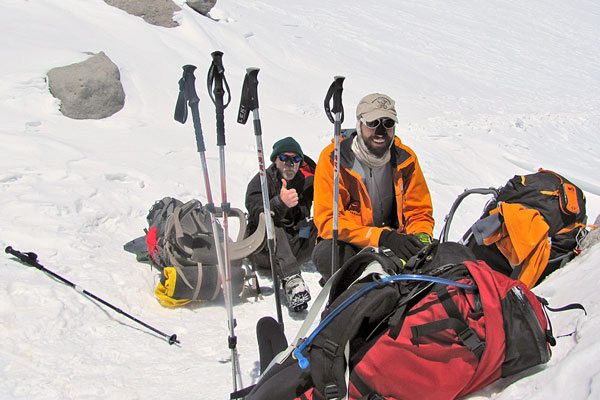by Norm Simons
I started technical climbing while in the Army in El Paso, Texas. With Steve Holm, another Port Angeles boy who was stationed at Ft. Carson, Colo., I did cross-country ski races and climbs in Colorado. That, and working in mountain parks, whetted my appetite for climbing high.
Along the way we climbed Kit Carson Peak, skied up the backside of Pikes Peak to the Summit, Longs Peak by two routes, Mount Whitney (three times), Mount Shasta, Mount Rainier, and in 2005, Kilimanjaro in Tanzania.
After Kilimanjaro my list of life goals dwindled to two peaks, Denali, which I had skied around in 1981 and Aconcagua, a 22,841-foot peak in Argentina. An Alaskan friend told me about a group called Cops on Top (COT), consisting of current and former police officers who climbed major peaks in honor of our fallen comrades in law enforcement.
I had contacted the group in 2010 in hopes of climbing Denali with them and was accepted to the team, but a last-minute potential job with the Alaska State Troopers loomed and I withdrew from the climb. That was unfortunate as the job fell through and COT made a successful climb of Denali. In solace, I climbed Rainier instead.
After major back surgery in December 2010, I was selected by COT to participate in a memorial climb in support of the family of Officer Jonathan Schmidt, killed in the line of duty while saving his supervisor.
About Cops on Top
While money was solicited from the public to help support our climb, most of the funds went to programs to help provide mental health counseling and programs such as Outward Bound to provide outdoor education opportunities for the children of fallen officers. An annual COT fundraiser is scheduled the last weekend of every June in most states having mountain peaks. It is known as the Summit For Heroes Climb.
While some of the equipment used during the climb is provided by COT, each climber essentially provides all of his/her gear, food, clothing, funding for travel and permits. For example, I ended up paying over $6,000 out of pocket.
The climb
After 10 months of training, I met members of the COT team in Littleton, Colo. We then flew to Miami, where we met remaining team members. On to Santiago, Chile, and finally Mendoza, Argentina. From there we bused to Los Penitentes, a ski resort, where we made final adjustments to our gear and met the “muleteers” who would pack much of our gear to base camp at the 13,000-foot level of Aconcagua.
The trailhead to the Vacas River route starts at 7,800 feet and gradually climbs over two nights and three days to base camp.
This two-night/three-day trek along the sparsely vegetated Vacas River afforded us our first real view of Aconcagua late on the second day.
On the third day we ascended a narrow canyon leading to a wide-open valley with spectacular views of the surrounding peaks, most over 16,000 feet, before arriving mid-afternoon at base camp. There the first order of business was a visit to the mountain doctor, who examined each team member.
We hiked up to Camp One at 16,200 feet, which like higher camps, was exposed to down-mountain winds of up to 60 mph. After complications from team members suffering from AMS (Altitude Mountain Sickness) and HAPE (High Altitude Pulmonary Edema) four of us ferried gear to Camp II at 19,000 feet. The next day I suffered the initial effects of HAPE and was forced to retreat to Base Camp. Four team members ascended to Camp II before making a successful climb to the summit.
One of the remaining two climbers contracted a near fatal case of HACE (High Altitude Cerebral Edema) that required a massive international rescue effort to save his life.
All in all, it was a successful climb from an expedition standpoint.
About the presenter:
Norm Simons is a Port Angeles native. He grew up hiking, backpacking, climbing and skiing in and around Olympic National Park. He served a two-year stint with the U.S. Army Military Police and is a 22-year veteran of the National Park Service as a law enforcement ranger, though he later “defected” to the National Oceanic and Atmospheric Administration as a special agent in marine law enforcement in the San Francisco Bay area.
He retired at age 57, and after a year returned to the peninsula, where he worked two details totaling 14 months for Sequim and Port Angeles police departments.
About the presentation:
Traveler’s Journal is a presentation of the Peninsula Trails Coalition. All of the money raised is used to buy project supplies and food to feed volunteers working on Olympic Discovery Trail projects.
Shows start at 7 p.m. in the Sequim High School cafeteria at 601 N. Sequim Ave. Cafeteria benches are hard and people should bring their own cushions.
Suggested donation is $5 for adults. Attendees 18 and younger are welcome for free.
Each week, one selected photo enlargement is given away as a door prize.
Call Dave Shreffler at 683-1734 for more information.



